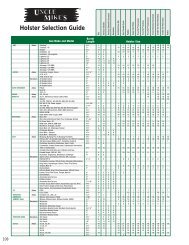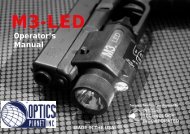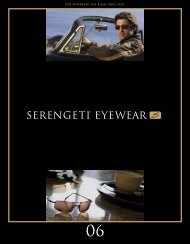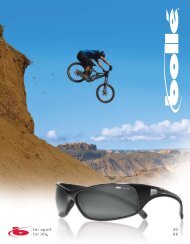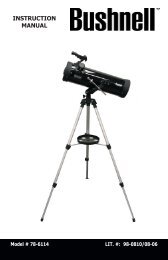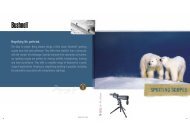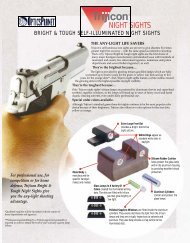INSTRUCTION MANUAL NexStar 80GTL - Celestron
INSTRUCTION MANUAL NexStar 80GTL - Celestron
INSTRUCTION MANUAL NexStar 80GTL - Celestron
You also want an ePaper? Increase the reach of your titles
YUMPU automatically turns print PDFs into web optimized ePapers that Google loves.
A telescope is an instrument that collects and focuses light. The nature of the optical design determines how the light is focused.<br />
Some telescopes, known as refractors, use lenses. Other telescopes, known as reflectors, use mirrors. Your <strong>NexStar</strong> 80 telescope<br />
is a refractor telescope that use an objective lens to collect its light.<br />
Focusing<br />
Once you have found an object in the telescope, turn the focusing knob until the image is sharp. To focus on an object that is<br />
nearer than your current target, turn the focusing knob toward the eyepiece (i.e., so that the focusing tube moves away from the<br />
front of the telescope). For more distant objects, turn the focusing knob in the opposite direction. To achieve a truly sharp focus,<br />
never look through glass windows or across objects that produce heat waves, such as asphalt parking lots.<br />
For astronomical viewing, out of focus star images are very diffuse, making them difficult to see. If you turn the focus knob too<br />
quickly, you can go right through focus without seeing the image. To avoid this problem, your first astronomical target should<br />
be a bright object (like the Moon or a planet) so that the image is visible even when out of focus.<br />
Image Orientation<br />
The image orientation of any telescope changes depending on how the eyepiece is inserted into the telescope. When observing<br />
through the <strong>NexStar</strong> 80 using the erect image diagonal, the image will be right side up, and correct from left to right. However,<br />
when observing straight through, with the eyepiece inserted directly into the telescope, the image will be inverted.<br />
Calculating Magnification<br />
Correct image as viewed when<br />
using erect image diagonal<br />
22<br />
Inverted image, as viewed with<br />
the eyepiece directly in telescope<br />
You can change the power of your telescope just by changing the eyepiece (ocular). To determine the magnification of your<br />
telescope, simply divide the focal length of the telescope by the focal length of the eyepiece used. In equation format, the<br />
formula looks like this:<br />
Focal Length of Telescope (mm)<br />
Magnification = ⎯⎯⎯⎯⎯⎯⎯⎯⎯⎯⎯⎯⎯⎯<br />
Focal Length of Eyepiece (mm)<br />
Let’s say, for example, you are using the 25mm eyepiece. To determine the magnification you simply divide the focal length of<br />
your telescope (for example, the <strong>NexStar</strong> 80 has a focal length of 900mm) by the focal length of the eyepiece, 25mm. Dividing<br />
900 by 25 yields a magnification of 36 power.<br />
Although the power is variable, each instrument under average skies has a limit to the highest useful magnification. The general<br />
rule is that 60 power can be used for every inch of aperture. For example, the <strong>NexStar</strong> 80 is 3.1” (80mm) in diameter.<br />
Multiplying 3.1 by 60 gives a maximum useful magnification of 186 power. Although this is the maximum useful magnification,<br />
most observing is done in the range of 20 to 35 power for every inch of aperture which is 62 to 109 times for the <strong>NexStar</strong> 80<br />
telescope.




